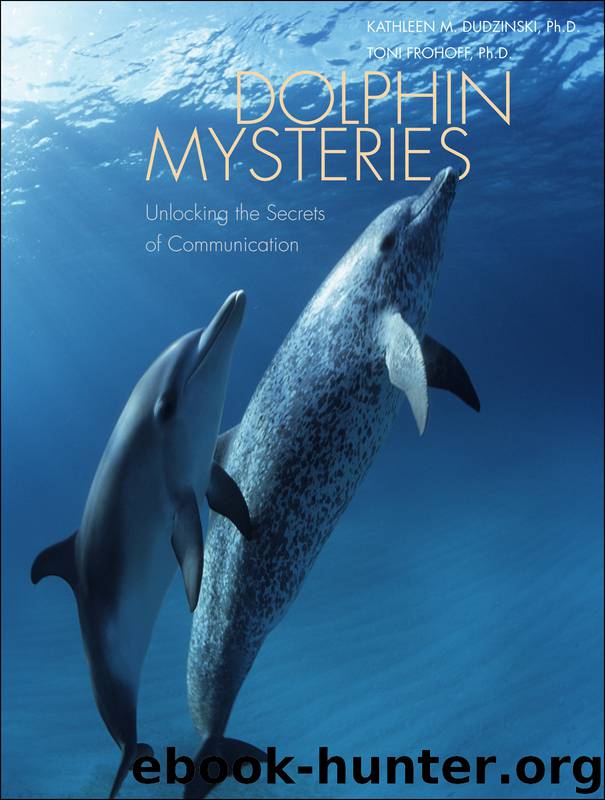Dolphin Mysteries by Kathleen M. Dudzinski & Toni Frohoff

Author:Kathleen M. Dudzinski & Toni Frohoff
Language: eng
Format: epub
Publisher: Yale University Press
Published: 2008-05-12T16:00:00+00:00
At times dolphins may leap just for fun … and sometimes leaps become part of a game of keep-away or tag. Spinner dolphins are named for their spinning leaps.
Not all scientists adopt this traditional stance regarding emotion in animals. Marc Bekoff argues that “those who claim that few if any animals have deep, rich, and complex emotional lives—that they cannot feel such emotions as joy, love, or grief—should share the burden of proof with those who argue otherwise.”104 In his view, we should ask, “Why must science assume that animals do not lead emotional lives in the first place?” If there is no evidence either way regarding emotion in animals, why prefer one stance over the other?
Thanks in part to the expanding toolbox of the cognitive revolution and a more scientific approach to the study of emotions in animals as advocated by Bekoff and others, scientists have made considerable progress in this area. Researchers have produced an enormous amount of data suggesting that there is good reason to accept that animals, like humans, have subjective experience of their emotional states.105 As we have seen in the many studies of cognition in dolphins, they may very well be self-aware and, consequently, highly aware of their own emotional experiences.Well-known reports concerning elephants, a large-brained social mammal whose matriarchal societies are not dissimilar in structure to many cetaceans (for example, killer and sperm whales), suggest that they display compassion and may assist other elephants in distress (both close kin and distant relatives).106 What’s more, they appear to have an awareness and curiosity of death and to suffer prolonged or permanent emotional damage reminiscent of post-traumatic stress disorder, as well as to produce abnormal or asocial behavior after exposure to severely traumatizing situations (such as witnessing the violent death of a family member).107 As Gay Bradshaw and her colleagues note in their landmark study of this psychological disorder, young elephants are particularly sensitive to such trauma. The removal of a matriarch from an elephant herd may severely damage the group for several generations, because inexperienced female elephants cannot rely on help from an older, more knowledgeable mother; a similar process occurs when key individuals are removed from close-knit orca family groups.108
When I (Toni) first heard about this work, I was relieved because it explained to me some of the signs of stress and distress in dolphins that I had observed. Twenty years ago, it was academically adventurous to use phrases like “behavioral indicators of internal states in dolphins” to describe what I now call emotions. Just recently, I was hired to assess the “psychological state” of a young dolphin who had been moved from one facility to another, from one social group to another. Government officials could not understand why the dolphin was not socializing with her new pod. Emotional stress caused by an imposed shift in social group or anxiety caused by separation from her mother are ideas now gaining acceptance in mainstream science. I have observed similar emotional expressions in free-ranging solitary orcas and belugas prematurely separated from their mothers by death or geography.
Download
This site does not store any files on its server. We only index and link to content provided by other sites. Please contact the content providers to delete copyright contents if any and email us, we'll remove relevant links or contents immediately.
The Lonely City by Olivia Laing(4120)
Animal Frequency by Melissa Alvarez(3755)
All Creatures Great and Small by James Herriot(3517)
Walking by Henry David Thoreau(3234)
Exit West by Mohsin Hamid(3184)
Origin Story: A Big History of Everything by David Christian(3139)
COSMOS by Carl Sagan(2950)
How to Read Water: Clues and Patterns from Puddles to the Sea (Natural Navigation) by Tristan Gooley(2855)
Hedgerow by John Wright(2777)
The Inner Life of Animals by Peter Wohlleben(2767)
Origin Story by David Christian(2684)
How to Read Nature by Tristan Gooley(2665)
Project Animal Farm: An Accidental Journey into the Secret World of Farming and the Truth About Our Food by Sonia Faruqi(2661)
How to Do Nothing by Jenny Odell(2645)
A Forest Journey by John Perlin(2588)
Water by Ian Miller(2584)
The Plant Messiah by Carlos Magdalena(2454)
A Wilder Time by William E. Glassley(2364)
Forests: A Very Short Introduction by Jaboury Ghazoul(2335)
